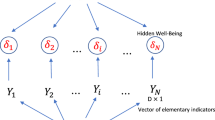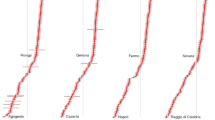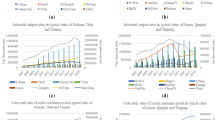Abstract
This study investigates subjective well-being in Japan using a survey of 22,539 respondents in 46 prefectures in December 2019. We applied a Bayesian hierarchical model to the self-reported well-being respondents, supposing that well-being is decomposed into regional and individual factors. As a result, regional heteroscedasticity and individual factors are identified jointly, which clarifies the interesting features of Japanese subjective well-being. From the identified regional factors in prefectural levels, we find that Social Welfare Expenditure (SWE) per capita and Ratio of Forest Area (RFA) are positively related to subjective well-being. Some prefectures in Capital Region, which are at the bottom of happiness ranking, are correlated with lower SWE and FRA. In addition, coastal areas in Tohoku region damaged by the 2011 tsunami and nuclear plant accidents also have relatively lower subjective well-being. This finding suggests that residents in the regions have not recovered and require additional mental and physical public support.






Similar content being viewed by others
References
Alesina, A., Di Tella, R., & MacCulloch, R. (2004). Inequality and happiness: Are Europeans and Americans different? Journal of Public Economics, 88(9–10), 2009–2042.
Argyle, M. (2013). The psychology of happiness. Routledge.
Bardasi, E., & Francesconi, M. (2004). The impact of atypical employment on individual wellbeing: Evidence from a panel of British workers. Social Science and Medicine, 58(9), 1671–1688.
Beja, E. L. (2014). Who is happier: Housewife or working wife? Applied Research in Quality of Life, 9(2), 157–177.
Benin, M. H., & Nienstedt, B. C. (1985). Happiness in single-and dual-earner families: The effects of marital happiness, job satisfaction, and life cycle. Journal of Marriage and the Family, 47(4), 975–984.
Blanchflower, D. G., & Oswald, A. J. (2004). Well-being over time in Britain and the USA. Journal of Public Economics, 88(7–8), 1359–1386.
Blanchflower, D. G., & Oswald, A. J. (2008). Is well-being u-shaped over the life cycle? Social Science and Medicine, 66(8), 1733–1749.
Buckley, R. (2020). Nature tourism and mental health: Parks, happiness, and causation. Journal of Sustainable Tourism, 28(9), 1409–1424.
Chatterjee, K., Chng, S., Clark, B., Davis, A., De Vos, J., Ettema, D., Handy, S., Martin, A., & Reardon, L. (2020). Commuting and wellbeing: A critical overview of the literature with implications for policy and future research. Transport Reviews, 40(1), 5–34.
Clark, A. E., & Oswald, A. J. (1994). Unhappiness and unemployment. The Economic Journal, 104(424), 648–659.
Clark, A. E., & Oswald, A. J. (1996). Satisfaction and comparison income. Journal of Public Economics, 61(3), 359–381.
Das, S. K. (2003). Harmful health effects of cigarette smoking. Molecular and Cellular Biochemistry, 253(1–2), 159–165.
Deaton, A. (2008). Income, health, and well-being around the world: Evidence from the gallup world poll. Journal of Economic Perspectives, 22(2), 53–72.
Easterlin, R. A. (1974). Does economic growth improve the human lot? Some empirical evidence. Nations and households in economic growth (pp. 89–125). Elsevier.
Easton, J. A., Confer, J. C., Goetz, C. D., & Buss, D. M. (2010). Reproduction expediting: Sexual motivations, fantasies, and the ticking biological clock. Personality and Individual Differences, 49(5), 516–520.
Frey, B. S., & Stutzer, A. (2010). Happiness and economics: How the economy and institutions affect human well-being. Princeton University Press.
Geiger, B. B., & MacKerron, G. (2016). Can alcohol make you happy? A subjective wellbeing approach. Social Science and Medicine, 156, 184–191.
Gerdtham, U.-G., & Johannesson, M. (2001). The relationship between happiness, health, and socio-economic factors: Results based on Swedish microdata. The Journal of Socio-Economics, 30(6), 553–557.
Gerlach, K., & Stephan, G. (1996). A paper on unhappiness and unemployment in Germany. Economics Letters, 52(3), 325–330.
Glass, J., Simon, R. W., & Andersson, M. A. (2016). Parenthood and happiness: Effects of work-family reconciliation policies in 22 OECD countries. American Journal of Sociology, 122(3), 886–929.
Graham, C. (2012). Happiness around the world: The paradox of happy peasants and miserable millionaires. Oxford University Press.
Graham, C., Higuera, L., & Lora, E. (2009). Valuing health conditions-insights from happiness surveys across countries and cultures. Technical report, IDB Working Paper Series.
Haller, M., & Hadler, M. (2006). How social relations and structures can produce happiness and unhappiness: An international comparative analysis. Social Indicators Research, 75(2), 169–216.
Helliwell, J. F. (2003). How’s life? Combining individual and national variables to explain subjective well-being. Economic modelling, 20(2), 331–360.
Hikichi, H., Aida, J., Kondo, K., & Kawachi, I. (2019). Persistent impact of housing loss on cognitive decline after the 2011 great east Japan earthquake and tsunami: Evidence from a 6-year longitudinal study. Alzheimer’s and Dementia, 15(8), 1009–1018.
Hilbrecht, M., Smale, B., & Mock, S. E. (2014). Highway to health? Commute time and well-being among Canadian adults. World Leisure Journal, 56(2), 151–163.
Inoguchi, T., & Shin, D. C. (2009). The quality of life in Confucian Asia: From physical welfare to subjective well-being. Social Indicators Research, 92(2), 183–190.
Ishino, T., Kamesaka, A., Murai, T., & Ogaki, M. (2012). Effects of the great east Japan earthquake on subjective well-being. Journal of Behavioral Economics and Finance, 5, 269–272.
Li, Q. (2018). Forest bathing: How trees can help you find health and happiness. Penguin.
Lim, S. S., Vos, T., Flaxman, A. D., Danaei, G., Shibuya, K., Adair-Rohani, H., AlMazroa, M. A., Amann, M., Anderson, H. R., Andrews, K. G., et al. (2012). A comparative risk assessment of burden of disease and injury attributable to 67 risk factors and risk factor clusters in 21 regions, 1990–2010: A systematic analysis for the global burden of disease study 2010. Lancet, 380(9859), 2224–2260.
Nikolaev, B. (2018). Does higher education increase hedonic and Eudaimonic happiness? Journal of Happiness Studies, 19(2), 483–504.
Nikolaev, B., & Rusakov, P. (2016). Education and happiness: An alternative hypothesis. Applied Economics Letters, 23(12), 827–830.
O’Connor, K. J., et al. (2017). Happiness and welfare state policy around the world. Review of Behavioral Economics, 4(4), 397–420.
Ohtake, F. (2004). The effects of unemployment on happiness. Japanese Journal of Labour Studies, 528, 59–68.
Ohtake, F., & Yamada, K. (2013). Appraising the unhappiness due to the great east japan earthquake: evidence from weekly panel data on subjective well-being. SSRN Electronic Journal.
Okulicz-Kozaryn, A. (2011). Geography of European life satisfaction. Social Indicators Research, 101(3), 435–445.
Oswald, A. J. (1997). Happiness and economic performance. The Economic Journal, 107(445), 1815–1831.
Pacek, A., & Radcliff, B. (2008). Assessing the welfare state: The politics of happiness. Perspectives on Politics (pp. 267–277).
Pierewan, A. C., & Tampubolon, G. (2014). Spatial dependence multilevel model of well-being across regions in Europe. Applied Geography, 47, 168–176.
Powdthavee, N. (2010). How much does money really matter? Estimating the causal effects of income on happiness. Empirical Economics, 39(1), 77–92.
Powdthavee, N., Lekfuangfu, W. N., & Wooden, M. (2015). What’s the good of education on our overall quality of life? A simultaneous equation model of education and life satisfaction for Australia. Journal of Behavioral and Experimental Economics, 54, 10–21.
Rasciute, S., & Downward, P. (2010). Health or happiness? What is the impact of physical activity on the individual? Kyklos, 63(2), 256–270.
Sato, T., & Matsuda, Y. (2021). Spatial extension of mixed analysis of variance models. Discussion Paper 120, Data Science and Service Research, Tohoku University, Sendai. http://www2.econ.tohoku.ac.jp/~DSSR/DDSR-DP/no120.pdf.
Stanca, L. (2010). The geography of economics and happiness: Spatial patterns in the effects of economic conditions on well-being. Social Indicators Research, 99(1), 115–133.
Sugano, S. (2016). The well-being of elderly survivors after natural disasters: Measuring the impact of the great east japan earthquake. The Japanese Economic Review, 67(2), 211–229.
Tanji, F., Tomata, Y., Sekiguchi, T., & Tsuji, I. (2018). Period of residence in prefabricated temporary housing and psychological distress after the great east japan earthquake: a longitudinal study. BMJ open, 8(5), e018211.
Tella, R. D., MacCulloch, R. J., & Oswald, A. J. (2003). The macroeconomics of happiness. Review of Economics and Statistics, 85(4), 809–827.
Tobler, W. R. (1970). A computer movie simulating urban growth in the detroit region. Economic Geography, 46(sup1), 234–240.
Treas, J., van der Lippe, T., & Tai, T.-O.C. (2011). The happy homemaker? Married women’s well-being in cross-national perspective. Social Forces, 90(1), 111–132.
Uchida, Y., Takahashi, Y., & Kawahara, K. (2014). Changes in hedonic and eudaimonic well-being after a severe nationwide disaster: The case of the great east japan earthquake. Journal of Happiness Studies, 15(1), 207–221.
Winkelmann, R. (2014). Unemployment and happiness. IZA World of Labor.
Yokoyama, Y., Otsuka, K., Kawakami, N., Kobayashi, S., Ogawa, A., Tannno, K., Onoda, T., Yaegashi, Y., & Sakata, K. (2014). Mental health and related factors after the great east Japan earthquake and tsunami. PloS One, 9(7), e102497.
Zimmermann, A. C., & Easterlin, R. A. (2006). Happily ever after? Cohabitation, marriage, divorce, and happiness in Germany. Population and Development Review, 32(3), 511–528.
Zurick, D. (2006). Gross national happiness and environmental status in Bhutan. Geographical Review, 96(4), 657–681.
Author information
Authors and Affiliations
Corresponding author
Additional information
Publisher's Note
Springer Nature remains neutral with regard to jurisdictional claims in published maps and institutional affiliations.
Rights and permissions
About this article
Cite this article
Li, A., Sato, T. & Matsuda, Y. Spatial analysis of subjective well-being in Japan. Jpn J Stat Data Sci 5, 87–110 (2022). https://doi.org/10.1007/s42081-021-00143-x
Received:
Revised:
Accepted:
Published:
Issue Date:
DOI: https://doi.org/10.1007/s42081-021-00143-x




